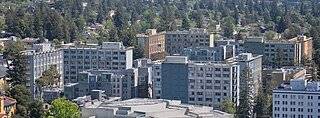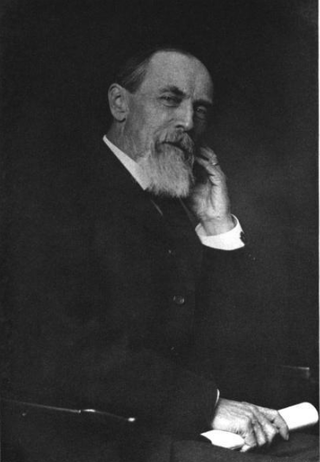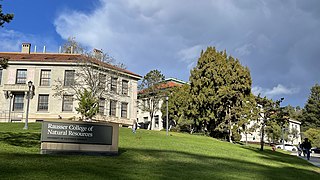
The University of California, Davis, is a public land-grant research university near Davis, California. Named a Public Ivy, it is the northernmost of the ten campuses of the University of California system. The institution was first founded as an agricultural branch of the system in 1905 and became the seventh campus of the University of California in 1959.

Bowles Hall is a coed residential college at the University of California, Berkeley, known for its unique traditions, parties, and camaraderie. Designed by George W. Kelham, the building was the first residence hall on campus, dedicated in 1929, and was California's first state-owned residence hall. It was built in 1928 with a $350,000 grant from Mary McNear Bowles in memory of her husband, Berkeley alumnus and University of California Regent Phillip E. Bowles. Mr. Bowles was said to have three loves: horses, horticulture and the University of California.

The University House is a residence and venue for official events on the campus of the University of California, Berkeley. Designed by the architect Albert Pissis and completed in 1911, it was formerly named President's House while it served as the home of the president of the University of California, starting with Benjamin Ide Wheeler and ending with Robert Gordon Sproul. Since 1965, it has been the home of the Chancellor of the Berkeley campus.
The William Randolph Hearst Greek Theatre, known locally as simply the Greek Theatre, is an 8,500-seat Greek Theatre owned and operated by the University of California, Berkeley in Berkeley, California, USA.

John Galen Howard was an American architect and educator who began his career in New York before moving to California. He was the principal architect at in several firms in both states and employed Julia Morgan early in her architectural career.

Housing at the University of California, Berkeley, includes student housing facilities run by the office of Residential and Student Service Programs (RSSP). Housing is also offered by off-campus entities such as fraternities and sororities and the Berkeley Student Cooperative (BSC).
The campus of the University of California, Berkeley, and its surrounding community are home to a number of notable buildings by early 20th-century campus architect John Galen Howard, his peer Bernard Maybeck, and their colleague Julia Morgan. Subsequent tenures as supervising architect held by George W. Kelham and Arthur Brown, Jr. saw the addition of several buildings in neoclassical and other revival styles, while the building boom after World War II introduced modernist buildings by architects such as Vernon DeMars, Joseph Esherick, John Carl Warnecke, Gardner Dailey, Anshen & Allen, and Skidmore, Owings and Merrill. Recent decades have seen additions including the postmodernist Haas School of Business by Charles Willard Moore, Soda Hall by Edward Larrabee Barnes, and the East Asian Library by Tod Williams Billie Tsien Architects.

Eugene Woldemar Hilgard was a German-American expert on pedology. An authority on climate as a soil forming factor, soil chemistry and reclamation of alkali soils, he is considered as the father of modern soil science in the United States.
The Berkeley Art Museum and Pacific Film Archive are a combined art museum, repertory movie theater, and archive associated with the University of California, Berkeley. Lawrence Rinder was Director from 2008, succeeded by Julie Rodrigues Widholm in August, 2020. The museum is a member of the North American Reciprocal Museums program.

Gilman Hall is a building on the campus of the University of California, Berkeley. Room 307 was where Glenn T. Seaborg and his coworkers identified plutonium as a new element on February 23, 1941 and as such, is designated a National Historic Landmark. The building itself is designated a National Historic Chemical Landmark, recognizing the two Nobel Prizes in Chemistry that have resulted from research done in the building.

South Hall is the oldest building on the campus of the University of California, Berkeley, built in 1873 in the Napoleon III style. It is the only remaining building of the original campus. South Hall was originally the counterpart of North Hall, which no longer exists, but was located where the Bancroft Library currently stands.

Harrison Richard Wellman was professor of agricultural economics at the University of California, Berkeley, and became acting president of the University of California in 1967.
The Giannini Foundation of Agricultural Economics was founded in the 1920s from a $1.5 million gift to the University of California from the Bancitaly Corporation in honor of its founder, A.P. Giannini. This fund has now grown to $20 million that is used to promote and support research on the economics of California agriculture. Members, which include faculty from various University of California campuses, may apply for grants to conduct research on California's agricultural economy and development. The findings are often reported in numerous publications.

Julia Morgan Hall is a historic building in the University of California Botanical Garden in Berkeley, California. Built in 1911, the building was designed by prominent California architect Julia Morgan and originally located on the central campus of the University of California, Berkeley, near the present location of the Haas School of Business. It served as a gathering place for Berkeley's female students, who wanted a female counterpart to Senior Hall, the senior men's meeting hall.

Durant Hall is a historical building in Berkeley, California. The Durant Hall was built in 1911. The building was listed on the National Register of Historic Places on March 25, 1982. When built, the Durant Hall, was the Boalt Memorial Hall of Law. In 1951, Durant Hall is renamed after the first president of the University of California Berkeley, Henry Durant (1802-1875), president from 1870 to 1872. The four-story Durant Hall was designed by architect John Galen Howard (1864-1931). The 17,000 sq foot Durant Hall was recently converted from the East Asian Library and Oriental Languages to the deans and administration for the College of Letters and Science. Boalt Hall was named after Judge John H. Boalt (1837–1901) as a memorial to him. His wife, Mrs. Elizabeth J. Boalt gave $100,000 for the memorial building. A group of California lawyers gave $50,000.

Hearst Gymnasium for Women, now called the Hearst Memorial Gymnasium, is a historical building in Berkeley, California. The Hearst Gymnasium for Women was built in 1927. The building and it site was listed on the National Register of Historic Places on March 25, 1982. The Hearst Gymnasium for Women was designed by Bernard Maybeck and Julia Morgan. The Hearst Gymnasium for Women was named after Phoebe Apperson Hearst (1842–1919), the mother of William Randolph Hearst (1863–1951). William Randolph paid for the gymnasium building as a memorial to his mother. The gymnasium replaced the original gymnasium that was lost in 1922 fire. The original wooden gymnasium was called Hearst Hall designed by Maybeck. Hearst Gymnasium for Women operated as retreat center for women, as it also had fine lodging, a fine dining hall, social center and three outdoor swimming pools. The building also houses the Phoebe A. Hearst Museum of Anthropology. The gymnasium has: dance studios, classrooms, conference rooms, a large and small gymnasium. Next to the gymnasium are the Hearst Tennis Courts, Hearst North Field, and the Hearst Field Annex. When opened the gymnasium also had an indoor rifle range.

Loring House , also called the William Lovering Locke House, is a historical building in Berkeley, California. The Loring House was built in 1914. The building and it site was listed on the National Register of Historic Places on July 13, 1989. The Loring House was designed by architect John Hudson Thomas (1878-1945) in a Prairie School architecture style. Thomas attended and graduated from both Yale in 1901 and University of California at Berkeley in 1904. The Loring House is located at 1730 Spruce Street, Berkeley. The two-story Loring House is a small home with a basement. It is built with a wood frame, stucco walls,flat rood and wood trim. The Prairie School architecture style has Viennese secessionist motifs in the interior and exterior. The house is the earliest example of Prairie School architecture in Berkeley. Prairie School architecture style was design of Frank Lloyd Wright (1867–1959), first found in the midwest and Chicago.

Giannini Hall is a historical building in Berkeley, California on the University of California Berkeley.. The Giannini Hall was built in 1930. The Giannini Hall building was listed on the National Register of Historic Places on March 25, 1982. The Giannini Hall was designed by architect William Charles Hays, with University of California, Berkeley. The Agricultural Complex has three buildings, Hilgard Hall, Wellman Hall, and Giannini Hall. Giannini Hall was funded by a donation from the Bancitaly Corporation, which also funded the The Giannini Foundation of Agricultural Economics in honor of Amadeo P. Giannini. Amadeo Pietro Giannini (1870–1949) was an Italian-American banker, he founded the Bank of Italy, which later became Bank of America. In honor of his Italian roots, the had old Tuscan farm style. Giannini Hall as buildings built around a center courtyard. The garden at the hall used stone pines, cypresses, and olive trees. Giannini Hall hold the agriculture research library.





















